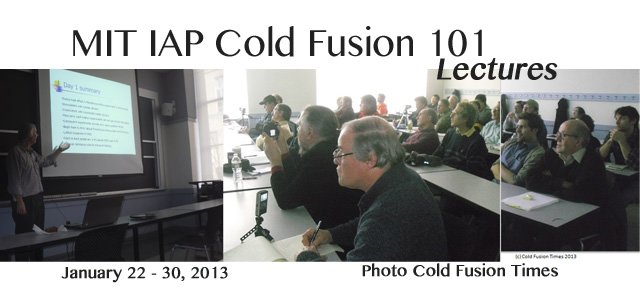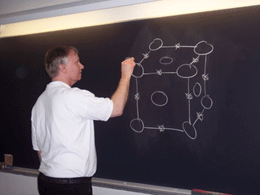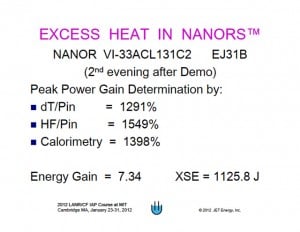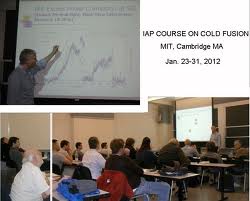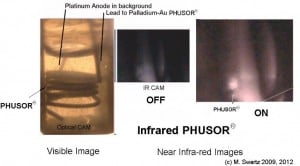MIT IAP short course Cold Fusion 101 is taking place and Jeremy Rys is posting video.
The course begins with the theoretical lectures by Dr. Peter Hagelstein, a principle investigator of the Research Laboratory of Electronics at Massachusetts Institute of Technology (MIT) and leading theoretician in the field of condensed matter nuclear science (CMNS).
A second part now ongoing features an experimental component as Dr. Mitchell Swartz of JET Energy demonstrates his NANOR device.
Demonstration of Excess Heat from a JET Energy NANOR at MIT [.pdf] is a report by the course co-teachers summarizing the NANOR’s excess heat results from last year.
Hagelstein begins the first day of this year’s course with a warning: this field can be dangerous for your career.
Then why the new course?
“A lot of reasons, one reason is there are starting to become jobs in this area. There are companies that are pursuing technology in this area.”
“I’ve been contacted a number of times and the question goes like this: ‘Do you know anybody who is qualified to take a position to lead this particular effort – and participate in the effort – in the cold fusion business?'”
“And the answer is ‘No, there’s no courses, there’s no training, there’s no way for anybody to get experience’.”
Here is the first part of the Cold Fusion 101 course lectures. We apologize about the poor audio. You may need an external amplifier to hear it. Please feel free to download and process audio for mp3 clean-up! (And send me a copy!)
Thank you to all who participated for allowing this video to broadcast.
From Cold Fusion Times:

Jan. 22, 2013 – On day 1, attendees intently focus on Prof. Peter Hagelstein’s lecture on palladium hydrides and the role of the highly loaded lattice, beyond the miscibility gap, as required for achieving successful deuterium fusion in cold fusion (LANR) as initially (correctly) reported by Drs. Fleischmann and Pons in 1989.
1 DAY 1 Part 1
2 DAY 1 Part 2
3 DAY 1 Part 3
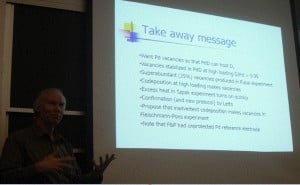 Jan. 23, 2013 – On day 2, Prof. Peter Hagelstein presented his original theory involving de novo helium formation in CF/LANR, specifically at vacancies surrounded by loaded octahedral sites, and made very clear -in that light- exactly why early attempts at reproduction of CF were so difficult to achieve. The roles of loading (Volmer, Tafel, and Heyrovsky reactions), chemical potential, sigma-bonded hydrogen, codeposition, embedded atom theories, vacancy diffusion and stabilization by loading, and the important differences between Pd and Ni were also made clear; as he tied these together based upon years of condensed matter data.
Jan. 23, 2013 – On day 2, Prof. Peter Hagelstein presented his original theory involving de novo helium formation in CF/LANR, specifically at vacancies surrounded by loaded octahedral sites, and made very clear -in that light- exactly why early attempts at reproduction of CF were so difficult to achieve. The roles of loading (Volmer, Tafel, and Heyrovsky reactions), chemical potential, sigma-bonded hydrogen, codeposition, embedded atom theories, vacancy diffusion and stabilization by loading, and the important differences between Pd and Ni were also made clear; as he tied these together based upon years of condensed matter data.
4 DAY 2 Part 1
Day 2 Part 1
Start Summary of Day 1
[copy Youtube]
13:40 Loading vs current density
16:11 Take away message Electro-chSummary
16:50 Does the migration of H or D into the metal off the surface affect these relationships?
17:50 What’s the best way to measure loading, is it the resistance?
18:46 Excess Power vs Loading in Pd-D systems
19:22 Loading vs. Power data correlation from SRI
20:00 Threshold holding value around 0.85 D/Pd or less
21:19 Revisit the electro-chemical model and Green-Britz.
22:50 Akita et al data re-produce loading
23:30 What about effect of current on loading with respect to time?
24:25 Loading ratio D/Pd =0.93 at SRI
26:09 Loading and resistance with Superwaves. Woah.
27:19 How can the loading be so high? Why, with the “moving” Volmer-Tafel model?
29:30 It’s not Volmer, it’s Tafel.
30:06 I have lots of fractures and voids and fissures increasing the surface area, allowing the D to leak out, and that will increase the Tafel.
30:50 “internal surfaces” meaning cracks where D leaks out
30:55 estimating that effect
5 DAY 2 Part 2
6 DAY 2 Part 3
 Jan. 24, 2013 – On day 3, Prof. Peter Hagelstein went through the experimental proof that de novo He4 production is commensurate with excess energy (Miles, and Case, and SRI experiments), and its rate of production is commensurate with excess power (Gozzi). He discussed the role of cell temperature in positive feedback in the CF/LANR system (Fleischmann, and Cravens, and Storms, and Swartz); and then focused on the problem associated with helium occupancy at the critical sites of CF/LANR in active systems. Moving through Rutherford issues to the Hamiltonian, he also demonstrated the roles of deuteron flux as well as loading. Finally, using an analogy similar to Corkum’s mechanism, he led the way towards the spin boson model of Cohen-Tannoudji, but demonstrated exactly where it was insufficient to explain CF/LANR in the absence of his discovery of the role of destructive interference and other loss and dephasing issues.
Jan. 24, 2013 – On day 3, Prof. Peter Hagelstein went through the experimental proof that de novo He4 production is commensurate with excess energy (Miles, and Case, and SRI experiments), and its rate of production is commensurate with excess power (Gozzi). He discussed the role of cell temperature in positive feedback in the CF/LANR system (Fleischmann, and Cravens, and Storms, and Swartz); and then focused on the problem associated with helium occupancy at the critical sites of CF/LANR in active systems. Moving through Rutherford issues to the Hamiltonian, he also demonstrated the roles of deuteron flux as well as loading. Finally, using an analogy similar to Corkum’s mechanism, he led the way towards the spin boson model of Cohen-Tannoudji, but demonstrated exactly where it was insufficient to explain CF/LANR in the absence of his discovery of the role of destructive interference and other loss and dephasing issues.
7 DAY 3 Part 1
8 DAY 3 Part 2
9 DAY 3 Part 3
Jan. 25, 2013 -On day 4, Prof. Hagelstein began with evidence, based upon PdD and D2O as the detectors, that de novo Helium 4 must be “borne” with energies below 10 keV or less, and that the upper limit for neutron production must be less than 0.01 neutrons/joule. Then, having demonstrated that destructive interference in the spin boson model prevents its use in CF/LANR, he corrected that, and expanded the Hamiltonian to now include coupling parameters and examined the quantum exchange characteristics based upon coherence.
Successful energy transfer was demonstrated to require interactions of all the atoms in the lattice. For further analysis, a donor-receptor system was then included. At that point, he showed how the Coulomb barrier need not be overcome, because by this method the factor is linear, rather than quadratic (needed for classical analysis of D+D interactions). Supporting this analysis is the Karabut data in glow discharge on Pd which yielded both diffuse emissions and collimated x-radiation. with beamlets of energy over a wide bandwidth, which were consistent with the theory Prof. Hagelstein developed.
Finally, he used the Foldy-Wouthuysen rotational operation, and demonstrated how this analysis is becoming asymptotic with what is being observed in CF/LANR, with the use of his corrected condensed matter nuclear science (CMNS) Hamiltonian. Finally, with the addition of nonlinear Rabi oscillations (which yields Dicke superradiance), his model was shown to also be near-complete and consistent with both the observed pulse emissions and the wide bandwidth.
10 DAY 4 Part 1 SUMMARY
11 DAY 4 Part II

